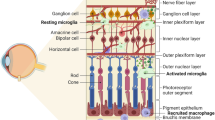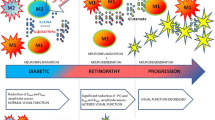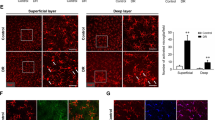Abstract
Emergent studies reveal the roles of inflammatory cells and cytokines in the development of diabetic retinopathy (DR), which is gradually portrayed as a chronic inflammatory disease accompanied by metabolic disorder. Through the pathogenesis of DR, macrophages or microglia play a critical role in the inflammation, neovascularization, and neurodegeneration of the retina. Conventionally, macrophages are generally divided into M1 and M2 phenotypes which mainly rely on glycolysis and oxidative phosphorylation, respectively. Recently, studies have found that nutrients (including glucose and lipids) and metabolites (such as lactate), can not only provide energy for cells, but also act as signaling molecules to regulate the function and fate of cells. In this review, we discussed the intrinsic correlations among the metabolic status, polarization, and function of macrophage/microglia in DR. Hyperglycemia and hyperlipidemia could induce M1-like and M2-like macrophages polarization in different phases of DR. Targeting the regulation of microglial metabolic profile might be a promising therapeutic strategy to modulate the polarization and function of macrophages/microglia, thus attenuating the progression of DR.


Similar content being viewed by others
References
Flaxman SR, Bourne RRA, Resnikoff S, et al. Global causes of blindness and distance vision impairment 1990–2020: a systematic review and meta-analysis. Lancet Glob Health. 2017;12:e1221–34.
Cheung N, Mitchell P, Wong TY. Diabetic Retinopathy. The Lancet. 2010;9735:124–36.
Wong TY, Cheung CM, Larsen M, et al. Diabetic Retinopathy. Nat Rev Dis Primers. 2016;2:16012.
Rubsam A, Parikh S, Fort PE. Role of inflammation in Diabetic Retinopathy. Int J Mol Sci. 2018;19:4.
Altmann C, Schmidt MHH. The Role of Microglia in Diabetic Retinopathy: inflammation, microvasculature defects and neurodegeneration. Int J Mol Sci. 2018;19:1.
Ghosh-Choudhary S, Liu J, Finkel T. Metabolic regulation of cell fate and function. Trends Cell Biol. 2020;3:201–12.
Shao Y, Chen J, Dong LJ, et al. A protective effect of PPARalpha in endothelial progenitor cells through regulating metabolism. Diabetes. 2019;11:2131–42.
Shao Y, Chen J, Freeman W, et al. Canonical Wnt signaling promotes neovascularization through determination of endothelial progenitor cell fate via metabolic profile regulation. Stem Cells. 2019;10:1331–43.
Haas R, Cucchi D, Smith J, et al. Intermediates of metabolism: from bystanders to signalling molecules. Trends Biochem Sci. 2016;5:460–71.
Buck MD, Sowell RT, Kaech SM, et al. Metabolic Instruction of Immunity. Cell. 2017;4:570–86.
Mosser DM, Edwards JP. Exploring the full spectrum of macrophages activation. Nat Rev Immunol. 2008;12:958–69.
Nau GJ, Richmond JF, Schlesinger A, et al. Human macrophages activation programs induced by bacterial pathogens. Proc Natl Acad Sci U S A. 2002;3:1503–8.
Freemerman AJ, Johnson AR, Sacks GN, et al. Metabolic reprogramming of macrophages: glucose transporter 1 (GLUT1)-mediated glucose metabolism drives a proinflammatory phenotype. J Biol Chem. 2014;11:7884–96.
Haschemi A, Kosma P, Gille L, et al. The sedoheptulose kinase CARKL directs macrophages polarization through control of glucose metabolism. Cell Metab. 2012;6:813–26.
Jha AK, Huang SC, Sergushichev A, et al. Network integration of parallel metabolic and transcriptional data reveals metabolic modules that regulate macrophages polarization. Immunity. 2015;3:419–30.
Martinez FO, Gordon S. The M1 and M2 paradigm of macrophages activation: time for reassessment. F1000Prime Rep. 2014;6:13.
Mantovani A, Biswas SK, Galdiero MR, et al. Macrophages plasticity and polarization in tissue repair and remodelling. J Pathol. 2013;2:176–85.
Doyle AG, Herbein G, Montaner LJ, et al. Interleukin-13 alters the activation state of murine macrophages in vitro: comparison with interleukin-4 and interferon-gamma. Eur J Immunol. 1994;6:1441–5.
Chistiakov DA, Bobryshev YV, Nikiforov NG, et al. Macrophages phenotypic plasticity in atherosclerosis: the associated features and the peculiarities of the expression of inflammatory genes. Int J Cardiol. 2015;184:436–45.
Huang SC, Everts B, Ivanova Y, et al. Cell-intrinsic lysosomal lipolysis is essential for alternative activation of macrophages. Nat Immunol. 2014;9:846–55.
Odegaard JI, Chawla A. Alternative macrophages activation and metabolism. Annu Rev Pathol. 2011;6:275–97.
Rodriguez-Prados JC, Traves PG, Cuenca J, et al. Substrate fate in activated macrophages: a comparison between innate, classic, and alternative activation. J Immunol. 2010;1:605–14.
O’neill LA. A broken krebs cycle in macrophages. Immunity. 2015;3:393–4.
Eid S, Sas KM, Abcouwer SF, et al. New insights into the mechanisms of diabetic complications: role of lipids and lipid metabolism. Diabetologia. 2019;9:1539–49.
Hendrick AM, Gibson MV, Kulshreshtha A. Diabetic Retinopathy. Prim Care. 2015;3:451–64.
Torres-Castro I, Arroyo-Camarena UD, Martinez-Reyes CP, et al. Human monocytes and macrophages undergo M1-type inflammatory polarization in response to high levels of glucose. Immunol Lett. 2016;176:81–9.
Pan Y, Wang Y, Cai L, et al. Inhibition of high glucose-induced inflammatory response and macrophages infiltration by a novel curcumin derivative prevents renal injury in diabetic rats. Br J Pharmacol. 2012;3:1169–82.
Cheng CI, Chen PH, Lin YC, et al. High glucose activates Raw264.7 macrophages through RhoA kinase-mediated signaling pathway. Cell Signal. 2015;2:283–92.
Xu X, Qi X, Shao Y, et al. High glucose induced-macrophages activation through TGF-β-activated kinase 1 signaling pathway. Inflamm Res. 2016;8:655–64.
Xu X, Fan Z, Qi X, et al. The role of TGF-β-activated kinase 1 in db/db mice and high glucose-induced macrophages. Int Immunopharmacol. 2016;38:120–31.
Al-Rashed F, Sindhu S, Arefanian H, et al. Repetitive intermittent hyperglycemia drives the m1 polarization and inflammatory responses in THP-1 macrophages through the mechanism involving the TLR4-IRF5 pathway. Cells. 2020;9:8.
Grosick R, Alvarado-Vazquez PA, Messersmith AR, et al. High glucose induces a priming effect in macrophages and exacerbates the production of pro-inflammatory cytokines after a challenge. J Pain Res. 2018;11:1769–78.
Pavlou S, Lindsay J, Ingram R, et al. Sustained high glucose exposure sensitizes macrophages responses to cytokine stimuli but reduces their phagocytic activity. BMC Immunol. 2018;1:24.
Fadini GP, Simoni F, Cappellari R, et al. Pro-inflammatory monocyte-macrophages polarization imbalance in human hypercholesterolemia and atherosclerosis. Atherosclerosis. 2014;2:805–8.
Bernelot Moens SJ, Neele AE, Kroon J, et al. PCSK9 monoclonal antibodies reverse the pro-inflammatory profile of monocytes in familial hypercholesterolaemia. Eur Heart J. 2017;20:1584–93.
Anderson EK, Hill AA, Hasty AH. Stearic acid accumulation in macrophages induces toll-like receptor 4/2-independent inflammation leading to endoplasmic reticulum stress-mediated apoptosis. Arterioscler Thromb Vasc Biol. 2012;7:1687–95.
Shan B, Wang X, Wu Y, et al. The metabolic ER stress sensor IRE1α suppresses alternative activation of macrophages and impairs energy expenditure in obesity. Nat Immunol. 2017;5:519–29.
Leng J, Chen MH, Zhou ZH, et al. Triterpenoids-enriched extract from the aerial parts of salvia miltiorrhiza regulates macrophages polarization and ameliorates insulin resistance in high-fat fed mice. Phytother Res. 2017;1:100–7.
Xiong XQ, Geng Z, Zhou B, et al. FNDC5 attenuates adipose tissue inflammation and insulin resistance via AMPK-mediated macrophages polarization in obesity Metabolism. 2018;83:31–41.
Cai D, Liu H, Wang J, et al. Balasubramide derivative 3C attenuates atherosclerosis in apolipoprotein E-deficient mice: role of AMPK-STAT1-STING signaling pathway. Aging (Albany NY). 2021;8:12160–78.
Ka SO, Song MY, Bae EJ, et al. Myeloid SIRT1 regulates macrophages infiltration and insulin sensitivity in mice fed a high-fat diet. J Endocrinol. 2015;2:109–18.
Hui X, Zhang M, Gu P, et al. Adipocyte SIRT1 controls systemic insulin sensitivity by modulating macrophages in adipose tissue. EMBO Rep. 2017;4:645–57.
Flynn MC, Pernes G, Lee MKS, et al. Monocytes, macrophages, and metabolic disease in atherosclerosis. Front Pharmacol. 2019;10:666.
Bekkering S, Quintin J, Joosten LA, et al. Oxidized low-density lipoprotein induces long-term proinflammatory cytokine production and foam cell formation via epigenetic reprogramming of monocytes. Arterioscler Thromb Vasc Biol. 2014;8:1731–8.
Rios FJ, Koga MM, Ferracini M, et al. Co-stimulation of PAFR and CD36 is required for oxLDL-induced human macrophages activation. PLoS ONE. 2012;5:e336632.
Rios FJ, Koga MM, Pecenin M, et al. Oxidized LDL induces alternative macrophages phenotype through activation of CD36 and PAFR. Mediators Inflamm. 2013;2013:198193.
Stoger JL, Gijbels MJ, Van Der Velden S, et al. Distribution of macrophages polarization markers in human atherosclerosis. Atherosclerosis. 2012;2:461–8.
Cho KY, Miyoshi H, Kuroda S, et al. The phenotype of infiltrating macrophages influences arteriosclerotic plaque vulnerability in the carotid artery. J Stroke Cerebrovasc Dis. 2013;7:910–8.
Peled M, Fisher EA. Dynamic aspects of macrophages polarization during atherosclerosis progression and regression. Front Immunol. 2014;5:579.
Rahman K, Vengrenyuk Y, Ramsey SA, et al. Inflammatory Ly6Chi monocytes and their conversion to M2 macrophages drive atherosclerosis regression. J Clin Invest. 2017;8:2904–15.
Yau JW, Rogers SL, Kawasaki R, et al. Global prevalence and major risk factors of Diabetic Retinopsthy. Diabetes Care. 2012;3:556–64.
Kowluru RA, Kowluru A, Mishra M, et al. Oxidative stress and epigenetic modifications in the pathogenesis of Diabetic Retinopathy. Prog Retin Eye Res. 2015;48:40–61.
Stefansson E, Olafsdottir OB, Eliasdottir TS, et al. Retinal oximetry: metabolic imaging for diseases of the retina and brain. Prog Retin Eye Res. 2019;70:1–22.
Kusuhara S, Fukushima Y, Ogura S, et al. Pathophysiology of Diabetic Retinopathy: The Old and the New. Diabetes Metab J. 2018;5:364–76.
Liew G, Lei Z, Tan G, et al. Metabolomics of Diabetic Retinopathy. Curr Diab Rep. 2017;11:102.
Chen L, Cheng CY, Choi H, et al. Plasma metabonomic profiling of Diabetic Retinopathy. Diabetes. 2016;4:1099–108.
Haines NR, Manoharan N, Olson JL, et al. Metabolomics analysis of human vitreous in Diabetic Retinopathy and rhegmatogenous retinal detachment. J Proteome Res. 2018;7:2421–7.
Kumagai AK. Glucose transport in brain and retina: implications in the management and complications of diabetes. Diabetes Metab Res Rev. 1999;4:261–73.
Klip A, Marette A, Dimitrakoudis D, et al. Effect of diabetes on glucoregulation. From glucose transporters to glucose metabolism in vivo. Diabetes Care. 1992;11:1747–66.
Badr GA, Tang J, Ismail-Beigi F, et al. Diabetes downregulates GLUT1 expression in the retina and its microvessels but not in the cerebral cortex or its microvessels. Diabetes. 2000;6:1016–21.
Fernandes R, Carvalho AL, Kumagai A, et al. Downregulation of retinal GLUT1 in diabetes by ubiquitinylation. Mol Vis. 2004;10:618–28.
Kumagai AK, Vinores SA, Pardridge WM. Pathological upregulation of inner blood-retinal barrier Glut1 glucose transporter expression in diabetes mellitus. Brain Res. 1996;2:313–7.
Lu L, Seidel CP, Iwase T, et al. Suppression of GLUT1; a new strategy to prevent diabetic complications. J Cell Physiol. 2013;2:251–7.
You ZP, Zhang YL, Shi K, et al. Suppression of Diabetic Retinopathy with GLUT1 siRNA. Sci Rep. 2017;1:7437.
Yokomizo H, Maeda Y, Park K, et al. Retinol binding protein 3 increased in the retina of patients with diabetes resistant to Diabetic Retinopathy. Sci Transl Med. 2019;11:499.
Ferrington DA, Fisher CR, Kowluru RA. Mitochondrial defects drive degenerative retinal diseases. Trends Mol Med. 2020;1:105–18.
Sena LA, Chandel NS. Physiological roles of mitochondrial reactive oxygen species. Mol Cell. 2012;2:158–67.
Kowluru RA, Kowluru A, Veluthakal R, et al. TIAM1-RAC1 signalling axis-mediated activation of NADPH oxidase-2 initiates mitochondrial damage in the development of Diabetic Retinopathy. Diabetologia. 2014;5:1047–56.
Roy S, Kim D, Sankaramoorthy A. Mitochondrial structural changes in the pathogenesis of Diabetic Retinopathy. J Clin Med. 2019;8:9.
Kowluru RA. Mitochondrial stability in Diabetic Retinopathy: lessons learned from epigenetics. Diabetes. 2019;2:241–7.
Malik AN, Rosa HS, De Menezes ES, et al. The detection and partial localisation of heteroplasmic mutations in the mitochondrial genome of patients with Diabetic Retinopathy. Int J Mol Sci. 2019;20:24.
Mohammad G, Radhakrishnan R, Kowluru RA. Epigenetic modifications compromise mitochondrial DNA quality control in the development of Diabetic Retinopathy. Invest Ophthalmol Vis Sci. 2019;12:3943–51.
Fumagalli S, Perego C, Pischiutta F, et al. The ischemic environment drives microglia and macrophages function. Front Neurol. 2015:6.
Rajamani U, Jialal I. Hyperglycemia induces toll-like receptor-2 and -4 expression and activity in human microvascular retinal endothelial cells: implications for Diabetic Retinopathy. J Diabetes Res. 2014.
Yao L, Kan EM, Lu J, et al. Toll-like receptor 4 mediates microglial activation and production of inflammatory mediators in neonatal rat brain following hypoxia: role of TLR4 in hypoxic microglia. J Neuroinflammation. 2013;10:23.
Butturini E, Boriero D, Carcereri De Prati A, et al. STAT1 drives M1 microglia activation and neuroinflammation under hypoxia. Arch Biochem Biophys. 2019;669: 22–30.
Tang J, Kern TS. Inflammation in Diabetic Retinopathy. Prog Retin Eye Res. 2011;5:343–58.
Fadini GP, Cappellari R, Mazzucato M, et al. Monocyte–macrophages polarization balance in pre-diabetic individuals. Acta Diabetol. 2013;6:977–82.
Fadini GP, De Kreutzenberg SV, Boscaro E, et al. An unbalanced monocyte polarisation in peripheral blood and bone marrow of patients with type 2 diabetes has an impact on microangiopathy. Diabetologia. 2013;8:1856–66.
Arroba AI, Alcalde-Estevez E, Garcia-Ramirez M, et al. Modulation of microglia polarization dynamics during Diabetic Retinopathy in db/db mice. Biochim Biophys Acta. 2016;9:1663–74.
Zeng H-Y, Green WR, Tso MOM. Microglial activation in human Diabetic Retinopathy. Arch Ophthalmol. 2008;2:227–32.
Hsieh CF, Liu CK, Lee CT, et al. Acute glucose fluctuation impacts microglial activity, leading to inflammatory activation or self-degradation. Sci Rep. 2019;1:840.
Chen C, Wu S, Hong Z, et al. Chronic hyperglycemia regulates microglia polarization through ERK5. Aging (Albany NY). 2019;2:697–706.
Holland R, Mcintosh AL, Finucane OM, et al. Inflammatory microglia are glycolytic and iron retentive and typify the microglia in APP/PS1 mice. Brain Behav Immun. 2018;68183–196.
Nair S, Sobotka KS, Joshi P, et al. Lipopolysaccharide-induced alteration of mitochondrial morphology induces a metabolic shift in microglia modulating the inflammatory response in vitro and in vivo. Glia. 2019;6:1047–61.
Hu Y, Mai W, Chen L, et al. mTOR-mediated metabolic reprogramming shapes distinct microglia functions in response to lipopolysaccharide and ATP. Glia. 2020;5:1031–45.
Mei X, Zhang T, Ouyang H, et al. Scutellarin alleviates blood-retina-barrier oxidative stress injury initiated by activated microglia cells during the development of Diabetic Retinopathy. Biochem Pharmacol. 2019;159:82–95.
Zhang T, Mei X, Ouyang H, et al. Natural flavonoid galangin alleviates microglia-trigged blood-retinal barrier dysfunction during the development of Diabetic Retinopathy. J Nutr Biochem. 2019;65:1–14.
Jo DH, Yun JH, Cho CS, et al. Interaction between microglia and retinal pigment epithelial cells determines the integrity of outer blood-retinal barrier in Diabetic Retinopathy. Glia. 2019;2:321–31.
Abu El-Asrar AM, Ahmad A, Allegaert E, et al. Interleukin-11 overexpression and M2 macrophages density are associated with angiogenic activity in proliferative Diabetic retinopathy. Ocul Immunol Inflamm. 2019;1–14.
Ding X, Gu R, Zhang M, et al. Microglia enhanced the angiogenesis, migration and proliferation of co-cultured RMECs. BMC Ophthalmol. 2018;1:249.
Li L, Heiduschka P, Alex AF, et al. Behaviour of CD11b-positive cells in an animal model of laser-induced choroidal neovascularisation. Ophthalmologica. 2017;1:29–41.
Liu Z, Xu J, Ma Q, et al. Glycolysis links reciprocal activation of myeloid cells and endothelial cells in the retinal angiogenic niche. Sci Transl Med. 2020;12:555.
Mendonca HR, Carpi-Santos R, Da Costa CK, et al. Neuroinflammation and oxidative stress act in concert to promote neurodegeneration in the diabetic retina and optic nerve: galectin-3 participation. Neural Regen Res. 2020;4:625–35.
Wang L, Pavlou S, Du X, et al. Glucose transporter 1 critically controls microglial activation through facilitating glycolysis. Mol Neurodegener. 2019;1:2.
Zhang T, Ouyang H, Mei X, et al. Erianin alleviates DR by reducing retinal inflammation initiated by microglia cells via inhibiting hyperglycemia-mediated ERK1/2-NF-kappaB signaling pathway. 2019;4:fj201802614RRR.
Kong L, Wang Z, Liang X, et al. Monocarboxylate transporter 1 promotes classical microglial activation and pro-inflammatory effect via 6-phosphofructo-2-kinase/fructose-2, 6-biphosphatase 3. J Neuroinflamm. 2019;1:240.
Dos-Santos-Pereira M, Guimaraes FS, Del-Bel E, et al. Cannabidiol prevents LPS-induced microglial inflammation by inhibiting ROS/NF-kappaB-dependent signaling and glucose consumption. Glia. 2020;3:561–73.
Li J, Yu S, Lu X, et al. The phase changes of M1/M2 phenotype of microglia/macrophages following oxygen-induced retinopathy in mice. Inflamm Res. 2021;2:183–92.
Chen J, Shao Y, Sasore T, et al. Interphotoreceptor retinol-binding protein ameliorates diabetes-induced retinal dysfunction and neurodegeneration through rhodopsin. Diabetes. 2021;3:788–99.
Acknowledgements
This work was supported by grants from National Natural Science Foundation of China (81900891) and Global Ophthalmology Awards Program 2020 (482667) to Yan Shao.
Author information
Authors and Affiliations
Corresponding author
Ethics declarations
Conflict of interest
None declared.
Additional information
Publisher's Note
Springer Nature remains neutral with regard to jurisdictional claims in published maps and institutional affiliations.
Rights and permissions
About this article
Cite this article
Wu, H., Wang, M., Li, X. et al. The Metaflammatory and Immunometabolic Role of Macrophages and Microglia in Diabetic Retinopathy. Human Cell 34, 1617–1628 (2021). https://doi.org/10.1007/s13577-021-00580-6
Received:
Accepted:
Published:
Issue Date:
DOI: https://doi.org/10.1007/s13577-021-00580-6




